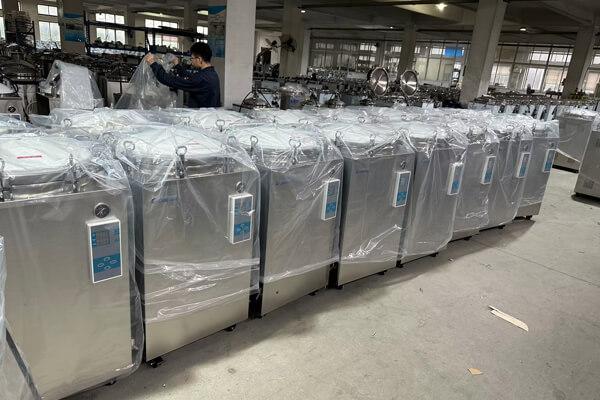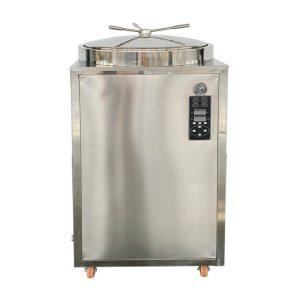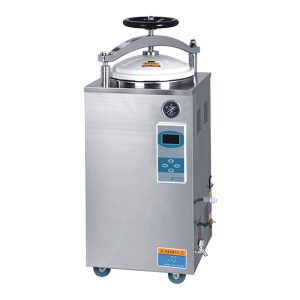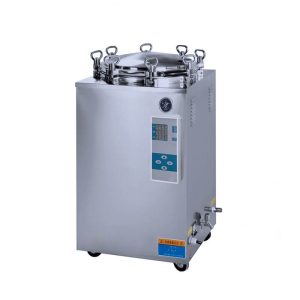High-pressure sterilization is a process that utilizes high-pressure steam
and elevated temperatures to eliminate microorganisms on the surface and within
an object. In this procedure, the object is placed within a high-pressure
chamber and subjected to high-temperature steam, typically within the range of
121°C to 134°C. This high-pressure steam effectively penetrates the object,
killing or disrupting the cellular structure of microorganisms, ensuring the
object attains a sterile state.
High-pressure sterilization finds widespread application in areas such as
healthcare, laboratories, food processing, and pharmaceuticals to ensure the
sterility of various objects. It is an efficient and reliable sterilization
method, particularly effective against heat-resistant spores and highly
resistant microorganisms. High-pressure sterilization plays a critical role in
maintaining a sterile environment during medical procedures, laboratory
operations, food production, and pharmaceutical manufacturing, preventing the
spread of bacteria and viruses.

autoclave
What is the difference between autoclave and sterilizer?
The main difference between a high-pressure sterilizer and a general sterilizer (usually referring to a steam sterilizer) lies in their sterilization methods and principles:
High-Pressure Sterilizer: A high-pressure sterilizer is a specific type of sterilization equipment that employs high-pressure steam and elevated temperatures to achieve sterilization. It generates high-pressure steam, typically maintaining higher temperatures (usually between 121°C and 134°C) during the process. This high-pressure steam has better penetration ability, effectively eliminating more heat-resistant microorganisms, such as spores. High-pressure sterilizers are primarily used in situations where a higher level of sterility is required, such as in the medical, laboratory, and pharmaceutical fields.
General Sterilizer: This term commonly refers to a steam sterilizer, which is a commonly used sterilization device. A steam sterilizer also employs steam to eliminate microorganisms, but it operates at relatively lower pressure, with temperatures typically ranging from 100°C to 121°C. This lower-temperature, lower-pressure steam can effectively kill many microorganisms but may be less effective against some highly heat-resistant spores and microorganisms.
In summary, high-pressure sterilizers have stricter requirements in terms of temperature and pressure, leading to a higher level of sterility, while general steam sterilizers are suitable for many applications where a certain degree of sterility is needed, such as for regular medical equipment sterilization.
What is a autoclave used for?
The primary purpose of a high-pressure sterilizer, also known as a steam autoclave, is to achieve complete sterilization of objects by using high-pressure steam and high temperatures. It effectively kills microorganisms, including bacteria, viruses, fungi, and spores, ensuring the objects reach a sterile state. The high-pressure sterilizer is widely used in various industries and applications, including but not limited to:
Medical Field:
It is used to sterilize medical instruments, surgical equipment, medical devices, and disposable medical supplies to maintain a sterile environment during surgeries and treatments, preventing bacterial infections and cross-contamination.
Laboratory:
The high-pressure sterilizer is employed to sterilize laboratory equipment, reagent bottles, and culture media bottles, ensuring the accuracy and reliability of laboratory work.
Food Industry:
It is utilized to sterilize food containers, cans, bottles, and packaging materials, ensuring food hygiene and extending shelf life.
Pharmaceutical Industry:
The high-pressure sterilizer is used to sterilize pharmaceutical containers and drug packaging, ensuring the sterility and stability of drugs.
Biotechnology:
It is applied in the biotechnology field to sterilize bioreactors, culture vessels, and culture media to maintain a pure experimental environment.
Overall, the high-pressure sterilizer serves the crucial purpose of providing reliable sterilization for a variety of objects, ensuring their sterility, and contributing to health and safety by preventing bacterial spread and infections.
What are the 3 types of sterilization?
There are several methods of sterilization, with three common types being:
1.Heat Sterilization: This method utilizes high temperatures to kill microorganisms. It includes dry heat sterilization and steam sterilization (also known as autoclaving). In dry heat sterilization, objects are exposed to elevated temperatures for a specific duration, while in steam sterilization, high-temperature steam, especially in high-pressure autoclaves, is used to eliminate microorganisms, typically at higher temperatures (ranging from 121°C to 134°C).
2.Chemical Sterilization: This approach employs chemical agents to eradicate microorganisms. The most common method is ethylene oxide gas sterilization, which is suitable for heat-sensitive objects. Other chemical disinfectants, such as hydrogen peroxide, can also be used for sterilization.
3.Radiation Sterilization: Ionizing radiation, such as gamma rays or electron beams, is utilized to eliminate microorganisms. This method is widely applied in pharmaceuticals, medical supplies, the food industry, and other areas requiring a high level of sterility.
Each of these sterilization methods has its advantages and limitations, and the specific choice depends on the nature of the object, the desired level of sterility, and the specific requirements of the field.
What is the difference between sterilize and autoclave?
Sterilization refers to the process of completely eliminating all microorganisms from an object through various physical or chemical means. Sterilization methods include high-temperature steam sterilization, dry heat sterilization, chemical sterilization, and radiation sterilization.
High-pressure sterilization, also known as steam autoclaving, is a specific method of sterilization. It utilizes high-pressure steam and high temperatures, typically within the range of 121°C to 134°C, to treat objects. The high-pressure steam can penetrate the objects, and the heat effectively kills microorganisms. High-pressure sterilization is a common and reliable method used extensively in medical, laboratory, and food industries.
In summary, high-pressure sterilization is a specific approach within the broader concept of sterilization. It harnesses the properties of high-pressure steam to achieve complete sterility of objects, while sterilization encompasses various methods to eliminate microorganisms from objects.
Why Autoclave is The Best Method of Sterilization
Autoclaving stands out as a highly effective method of sterilization for several reasons: 1.Comprehensive Microbial Elimination: Autoclaves use high-pressure steam, typically at temperatures above 121°C
Why is autoclaving done for 15 minutes?
The reason high-pressure sterilization typically takes 15 minutes or more is to ensure the thorough elimination of various microorganisms, including bacteria, viruses, fungi, and spores.
How an Autoclave Works
The high-pressure sterilizer functions based on a fundamental principle that leverages elevated temperature and pressure to achieve potent disinfection. Here’s a simplified explanation of its
How to clean autoclave monthly
Regularly cleaning and maintaining the high-pressure sterilizer each month is essential to ensure its proper functioning and effectiveness in disinfection. Here are the general steps
How Does an Autoclave Work
A high-pressure sterilizer operates by placing objects within a sealed chamber and introducing high-temperature, high-pressure steam. The working process can be summarized in the following
What is Autoclave Sterilization
High-pressure sterilization is a process that utilizes high-pressure steamand elevated temperatures to eliminate microorganisms on the surface and withinan object. In this procedure, the object




